Introduction
(For a html version of this go to EMF vectors.
This is about playing with numerous ways the three right angle vectors of an electro-magnetic event can be arranged that can produce a custom electro-magnetic envelope that has intrinsic characteristics.
There are a lot of “What ifs?” on this web page. The author recognizes his ignorance. As the movie goes, I “know two things Jack and sh*t; and Jack left town.” The intention of this webpage is to examine the basics of an electromagnetic event and pique other people’s curiosity and have them go “Hmmm, that’s a good question. Let’s find out.”

Many of the questions presented here could not be answered by the author’s college instructors and may not be answerable without direct experimentation. There are probably a few people (several thousand, actually) that have answers to some of the questions posed here; the answers to a few of these questions may be obvious to them.
Another thing that was learned from electronics and world history concurrently was how mankind would develop a concept and then crystallizes in that concept. Examples are Greek pottery and TV or AC distribution. With Greek pottery, they developed 5 different pots for a multitude of purposes. Once these pots were established, no other types of pots were made. They crystallized in their thinking.
With TV and AC distribution, both were first developed in the US. The US developed a system that delivers 117 volts at 60 Hz and kept it there. Europe developed their system later with ~220 volts at 50 Hz which tended to be able to deliver more energy. A similar thing occurred with TV.
Again, the primary intention of this webpage is to awaken people’s curiosity. “What happens if we do this?” The idea is to get people to re-examine some crystallized thought.
The Playing Field
An electro-magnetic event involves three right angle vectors, a changing electric field, a changing magnetic field, and a change of space at light speed -- c. These three right angle vectors define 3-dimensional solid matter as we experience it.

A creation of one vector automatically creates the other two; a changing electric field creates a changing magnetic field with a change of space, while a changing magnetic field creates a changing electric field and change of space, and a change of space (close to c) creates a changing electric field and a changing magnetic field.
Be advised, our knowledge of EMF is based on its reaction to matter. All matter that we experience is comprised of an electric field matrix of electrically charged particles. This electric field matrix manifests in non-organic -- non living -- matter as crystalline in nature as an ordered array. While, organic – living -- matter is comprised of electric field matrices within matrices, within matrices…
One element of a crystallized atomic/molecular matrices have particles or collection of electrically charged – positive -- particles that are relatively stable in space – do not move much, are the atomic nuclei, and act as ‘place holders’ within a crystallized electric field matrix. Their relatively constant spatial relationship is an integral part of a crystalline lattice. While, the negative electrically charged particles – electrons -- are in a constant change of relatively large distances of space and move
between the ‘place holders’.
The electric field matrices developed by these electrically charged particles determine the apparent qualities of the material -- characteristics, some of these qualities are intrinsic to that matrix. An example is carbon. A carbon electric field matrix can have the characteristics of soot, activated charcoal, or that of a diamond; the matrix the material is in defines the apparent characteristics of material.
Some of the characteristics of relatively simple crystalline matrices are:[INDENT]1. If the electric field matrix field strengths are so strong that the moving electrons are locked into the matrix and do not respond to an outside electric field and are not allowed to leave their place around their respective nuclei, that material is considered an insulator.
2. If the electric field matrix field strengths are loose enough that they can respond to an outside electric field, yet the electrons not leave the immediate nucleus, and the matrix can transmit the field through electric induction – atoms or molecules become electrically polarized, that material is considered a dielectric.
3. If the electric field matrix field strengths are loose enough that electrons are allowed to leave the immediate nucleus vicinity, the material is considered a conductor.
4. If the electric field matrix field strengths are tight under one set of conditions (1) and loose under another set of conditions (3), that material exhibits semi-conductor properties.
5. If the electric field matrix allows for circular movement patterns of the electrons, the material exhibits magnetic qualities[INDENT]
As to the qualities of each EMF vector, each vector componant is somewhat different. Here is a comparision list of some of their known qualities.
Electric field
Stores energy
• Measured in voltage
• Can vary in field strength -- density
• Can be stopped by an atomic/molecular electric field matrix -- can be insulated against
Physical strength
• the inverse square law is involved
• an infinite energy potential is available
Polar in quality
• A change of electric field uses two points – references
• Referenced from positive to negative
• Opposite poles attract, similar poles repell
• The change of an electric field is considered between these two references, either in distance or in strength
• If either reference changes like in charge strength or distance the field density changes
Magnetic field
Stores energy
• Measured in gauss
• Can vary in strength -- density
• Can not be stopped by an atomic/molecular electric field matrix – can not be insulated against
• Some amount can be absorbed by the complex organic – living -- electric field matrices, kind of like a sponge.
Physical strength
• Does not work with the inverse square law
• Much weaker than the electric field
Polar in quality
• Referenced from north to a south
• A change of magnetic field uses these two references
• Opposite poles attract, similar poles repell
• Distance between poles changes field density
• The change of an magnetic field is considered between these two references, either a change of distance -- spatial reference -- or in strength
• If either reference changes like in flux strength or distance the field density changes
Change of space
With movement of mass, it stores energy
Strength
• When generated by either a changing electric or magnetic fields, it can not be stopped
• Is a constant – c
Polar in quality
• The polar qualities are in time and space
• A change of space occurs in a change of time and vice versa
• Both of these time and space values are dependent on frequency and are relatively constant for a given frequency
Create any two of the EMFvectors and the third vector created is more powerful: Stores energy
• Measured in voltage
• Can vary in field strength -- density
• Can be stopped by an atomic/molecular electric field matrix -- can be insulated against
Physical strength
• the inverse square law is involved
• an infinite energy potential is available
Polar in quality
• A change of electric field uses two points – references
• Referenced from positive to negative
• Opposite poles attract, similar poles repell
• The change of an electric field is considered between these two references, either in distance or in strength
• If either reference changes like in charge strength or distance the field density changes
Magnetic field
Stores energy
• Measured in gauss
• Can vary in strength -- density
• Can not be stopped by an atomic/molecular electric field matrix – can not be insulated against
• Some amount can be absorbed by the complex organic – living -- electric field matrices, kind of like a sponge.
Physical strength
• Does not work with the inverse square law
• Much weaker than the electric field
Polar in quality
• Referenced from north to a south
• A change of magnetic field uses these two references
• Opposite poles attract, similar poles repell
• Distance between poles changes field density
• The change of an magnetic field is considered between these two references, either a change of distance -- spatial reference -- or in strength
• If either reference changes like in flux strength or distance the field density changes
Change of space
With movement of mass, it stores energy
Strength
• When generated by either a changing electric or magnetic fields, it can not be stopped
• Is a constant – c
Polar in quality
• The polar qualities are in time and space
• A change of space occurs in a change of time and vice versa
• Both of these time and space values are dependent on frequency and are relatively constant for a given frequency
Create a changing electric and magnetic vector
and the change of space, with minor exceptions, never changes – c.
Create a changing magnetic field and a change of space
If the change of space of is a conductor matrix moving within that magnetic field we have power generation.
If the changing space is the expanding and collapsing of magnetic field and it is the field that is moving through a conductor, this is magnetic induction -- transformers.
Change of electric and a change of space
Depending on the type of motion, the material has magnetic qualities, See (5) above
Admittedly, this is an over simplification of an electro-magnetic event. All our electrical doodads are based on applications of -- playing with – these three vectors. and the change of space, with minor exceptions, never changes – c.
Create a changing magnetic field and a change of space
If the change of space of is a conductor matrix moving within that magnetic field we have power generation.
If the changing space is the expanding and collapsing of magnetic field and it is the field that is moving through a conductor, this is magnetic induction -- transformers.
Change of electric and a change of space
Depending on the type of motion, the material has magnetic qualities, See (5) above
With most conductive devices, the initial EMF generated by that device has a spatial polarization such the movement vector is toward the device; the electromagnetic field created by the electric field in the wire and the magnetic field created by the electron movement has change of space polarized to move inward.

The like – same field direction -- polarized fields that are constantly being created push the previously created fields away from the device; it pushes energy away from the device in the opposite direction of the spatial vector created by the fields – towards the device. When the initial electric field – pressure/voltage -- begins to weaken, then the motion vector causes the EM field to collapse in on the device; the stored energy is putting back into the system.
For the most part, the electric field and the magnetic field are in phase – occur at the same time. The magnetic field can lag in phase behind the electric field some, depending on the self induction of the device.
DIPOLE FEED CONFIGURATION SCHEMATICS
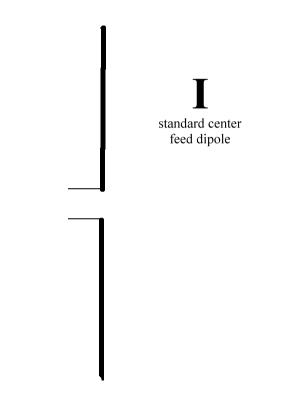
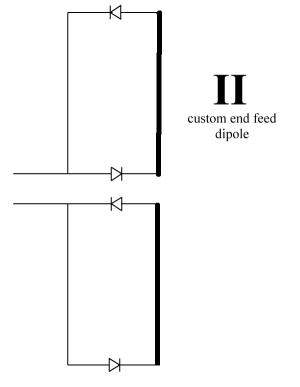
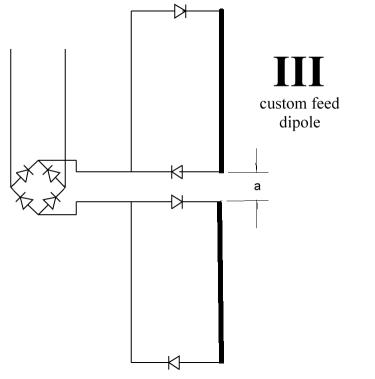
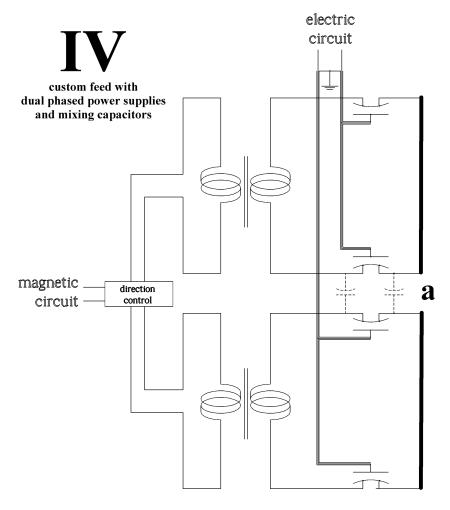
With EMF producing devices like dipole antennas (I), the initial fields created are different. The first quarter wavelength has the motion vector -- change of space -- away from the device. The second quarter wavelength, as voltage decreases produces a motion vector that collapses towards the device, the third quarter wavelength away from the device, and the forth towards, etc. (I-A)

Some radio wave characteristics are:
A typical dipole antenna’s (I) initial field structure has the electric and magnetic field elements being radiated 90o out of phase (I-A). A changing magnetic field is initial and weakens as the electric field strengthens until it is nonexistent when the electric field is at max
The initial right angle change of space vector is away from the antenna. Then, as the current flow changes, the magnetic field goes in the opposite direction and is the strongest as the electric field becomes non-existent as it reverses polarity. The right angle change of space vector is now goes towards the antenna (I-A). As the reverse polarized electric field gains strength, the magnetic field weakens, etc.
This 90o out phase production is the antenna’s induction field with alternating direction vectors. Outside of the induction field (about one or two wavelengths), the electric field and the magnetic field make a transition and become in phase with a continual change of space away from the antenna (I-A). Let’s call this transition point 1.
Some of the questions below are asked in referenced to a dipole antenna (or similar device) hooked up in in a number of waysin order to produce specfic electric and magnetic fields (as shown in the schematics) . It is recognized that with some of the more advanced ideas (III or IV), the schematics may stay the same but the devices may evolve to be something other than a simple dipole. The dipoles in those drawings are there to represent devices that produce the fields illustrated.
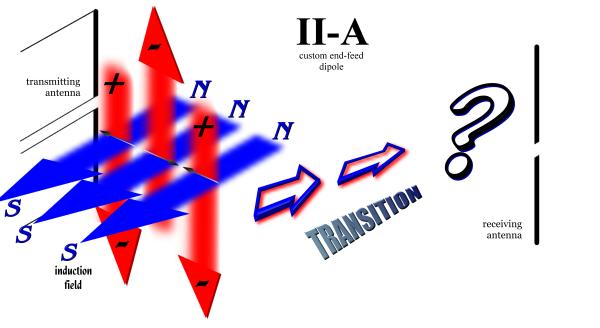
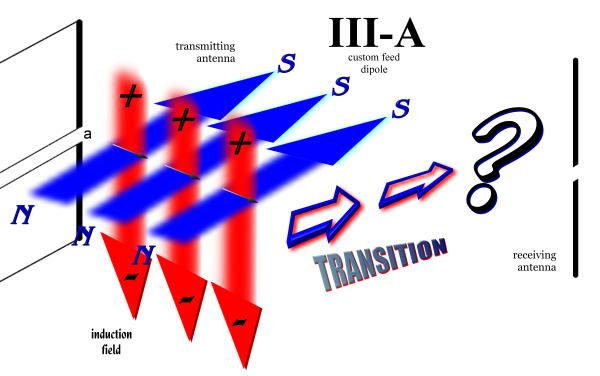
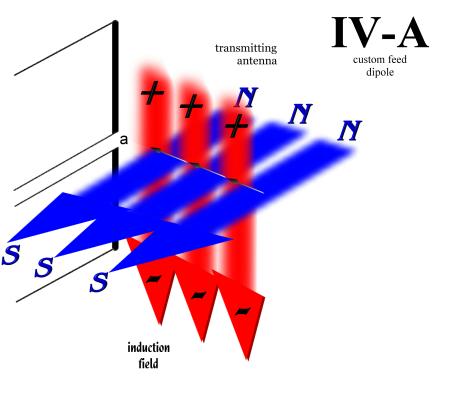
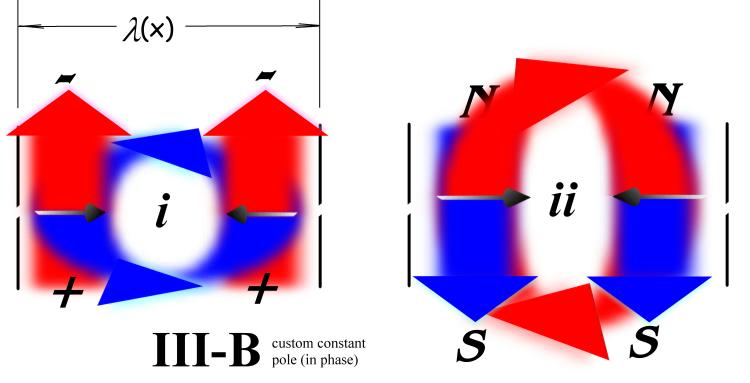
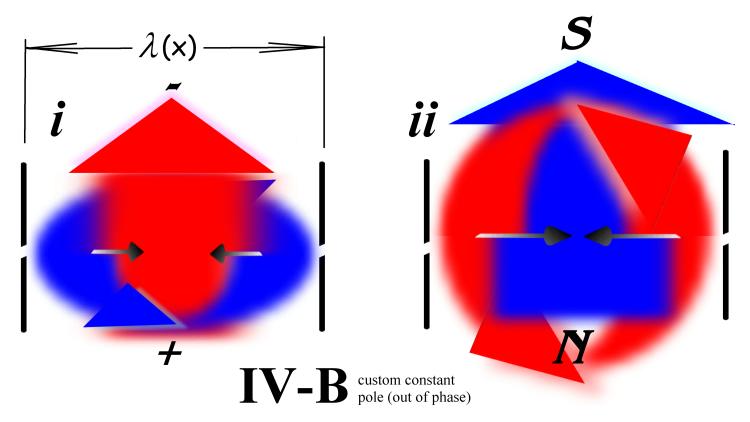
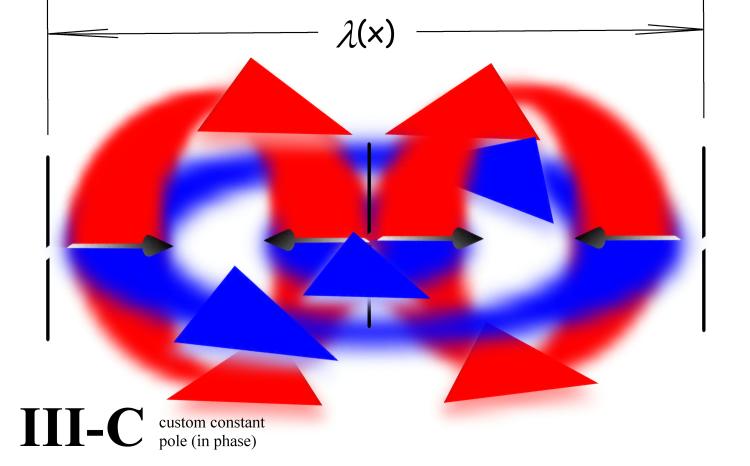
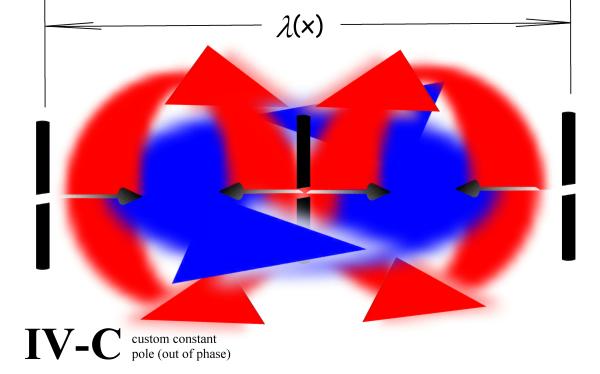
Comment